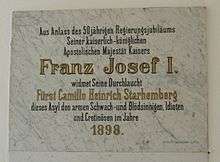Schloss Hartheim
Schloss Hartheim, also known as Hartheim Castle, is a castle at Alkoven in Upper Austria, some 14 kilometres (9 mi) from Linz, Austria. It was built by Jakob von Aspen in 1600, and it is a prominent Renaissance castle in the country. The building became notorious as one of the Nazi Euthanasia killing centres, where the killing program Action T4 took place.

In 1898, Prince Camillo Heinrich Starhemberg (1835–1900) donated the castle as a gift to the Upper Austria Charity Organization. With the help of additional donations, they used the castle from the beginning of the 20th century as a psychiatric institution (German: Psychiatrische Anstalt, but originally called the Idioten-Anstalt).
History to 1940

Hartheim lies in the middle of the so-called Eferding Basin, that runs along the River Danube from Ottensheim to Aschach an der Donau. As early as 1130, a family with the name Hartheim is mentioned in the records. They were vassals of the bishops of Passau. In 1287, three brothers, Conrad, Peter and Henry of Hartheim, were named as owners of the castle as part of a barter arrangement with the Wilhering Abbey. In any case by 1323, another family was named as the owners. Until the middle of the 14th century the site consisted mainly of just one tower, subsequently a residence was added and it was surrounded by a small wall with ramparts and ditches.
After changing hands several times the castle ended up in the possession of the Aspen family, who probably built the castle into its present shape. At the beginning of the 1690s they had a completely new castle built conforming to perceptions of the ideal Renaissance style with a regular four-winged building with four polygonal corner towers and a higher central tower.
In 1799, George Adam, Prince of Starhemberg, purchased the castle. However, by 1862 the castle was in a rather poor condition, as a contemporary report describes: Doors, windows and ovens are entirely missing, ... and several ceilings must be replaced.
In 1898, Camillo Henry, Prince of Starhemberg, made a present of the castle building, the outbuildings and some land to the Upper Austrian State Welfare Society (Oberösterreichischen Landeswohltätigkeitsverein or OÖ. LWV). It was intended to use further donation to convert the building into an "Idiot's Institute" as it was described at the time. In addition between 1900 and 1910 major renovation and conversion work was carried out to enable the building to be used as a care home for mentally handicapped people. In 1926, a staircase was dismantled and replaced by a bed lift.
Nazi era and aftermath
Following Hitler's euthanasia decree in 1939, Hartheim was selected as one of six euthanasia centres in the Reich. Between May 1940 and December 1944, approximately 18,000 people physically and mentally disabled were killed at Schloss Hartheim by gassing and lethal injection as part of the T-4 Euthanasia Program, named after the infamous Berlin address "Tiergartenstrasse 4".[1] These included about twelve thousand prisoners from the Dachau and Mauthausen concentration camps who were sent here to be gassed,[2] as were hundreds of women sent from Ravensbrück concentration camp in 1944, predominantly sufferers of TB and those deemed mentally infirm .[3] The castle was regularly visited by the psychiatrists Karl Brandt, Professor of Psychiatry at Würzburg University, and Werner Heyde. In December 1944 Schloss Hartheim was closed as an extermination centre and restored as a sanatorium after being cleared of evidence of the crimes committed therein.
In 1946, Alice Ricciardi-von Platen, a psychiatrist and psychoanalyst who practised near Linz, Austria, was invited to join the German team observing the so-called Doctors Trial in Nuremberg. The trial was presided over by American judges, who indicted Karl Brandt and 22 others. The 16 who were convicted included Dr Josef Mengele; seven were sentenced to death. Her 1948 book, Die Tötung Geisteskranker in Deutschland, ("The killing of the mentally ill in Germany"), was judged a scandal by German medical professionals.[4][5]
After World War II, the building was converted into apartments. Beginning in 1969, the gas chamber was opened to visitors. Hartheim Castle is now a memorial site dedicated to the thousands of physically and mentally handicapped persons who were murdered here by the Nazis.[6]
See also
- Nazi Euthanasia Programme - Action T4
- Action 14f13
Further reading
- Angela Gluck Wood, Holocaust - the events and their impact on real people Foreword by Steven Spielberg. Lots of photos. DK Publishing (2007) ISBN 978-0-75662-535-1
Sources
- Pierre Serge Choumoff, Les Assassinats Nationaux-Socialistes par Gaz en Territoire Autrichien, Vienna, Bundesministerium für Inneres, 2000, ISBN 978-3-9500867-1-3
- Nazi Medicine and the Nuremberg Trials (PDF) Table of contents, introduction and index only.
- Eutanasia, le radici dello sterminio (in Italian)
References
- Klee: Dokumente zur Euthanasie, p. 232 f.
- Klee: Euthanasie im Dritten Reich, p. 290.
- Helm, Sarah, 'If This Is A Woman. Inside Ravensbrück : Hitler's Concentration Camp for Women', pp.453-455.
- "Alice Ricciardi-von Platen obituary". Archived from the original on June 4, 2011. Retrieved 2011-05-01.CS1 maint: BOT: original-url status unknown (link) The Times online. (April 15, 2008) Retrieved May 17, 2010
- Paul Weindling, Alice Ricciardi-von Platen obituary The Guardian (March 13, 2008) Retrieved May 17, 2010
- Schloss Hartheim memorial and documentation center Official website. Retrieved May 17, 2010
External links
- Schloss Hartheim - official site